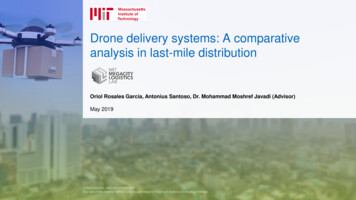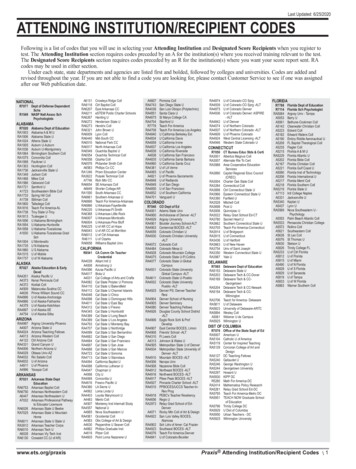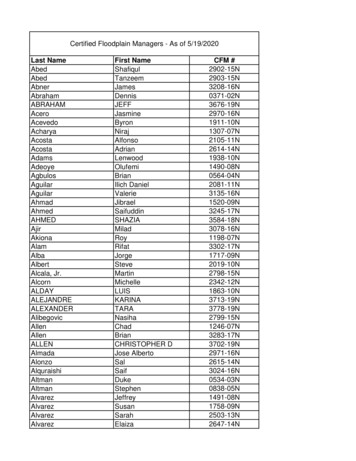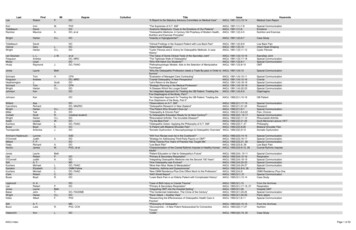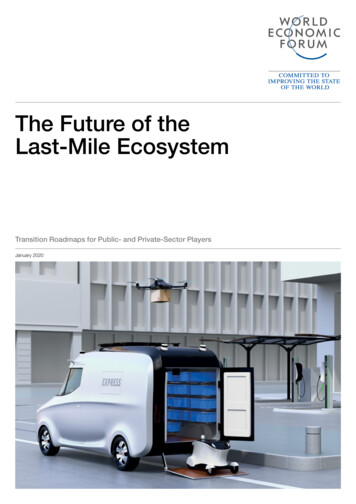
Transcription
The Future of theLast-Mile EcosystemTransition Roadmaps for Public- and Private-Sector PlayersJanuary 2020
World Economic Forum91-93 route de la CapiteCH-1223 Cologny/GenevaSwitzerlandTel.: 41 (0)22 869 1212Fax: 41 (0)22 786 2744Email: contact@weforum.orgwww.weforum.org 2020 World Economic Forum. All rightsreserved. No part of this publication may bereproduced or transmitted in any form or by anymeans, including photocopying and recording, orby any information storage and retrieval system.
ContentsExecutive summary4Context: Unparalleled growth in last-mile transport6Urbanization: Space as the scarcest resource7E-commerce has a rapidly growing customer base7New categories move online and new businessmodels emerge7Faster delivery is the new normal8Delivery technologies transform the last mile8E-commerce has an impact on both people andgoods transport9Base case: Emerging challenges for the ecosystem10Congestion, emissions and delivery cost: Keychallenges if no effective intervention takes place10Urban freight has a disproportionately high impact12Nascent city activities and interventions12Last-mile interventions13Interventions grid: Overview of 24 prioritized interventions13Last-mile simulation: Quantified impact of interventions13Transition scenarios: Recommendations toecosystem players20The transition scenarios with different target functions20Timeline for implementation22Public- and private-sector collaboration foraccelerated impact22Set-up of city platforms22Robust, harmonized regulatory environment23Effective use of data and analytics24Contributors25Acronyms25Endnotes26The Future of the Last-Mile Ecosystem3
Executive summaryThere has never been a time of greater change for the “lastmile”. Consumers order more things online, expecting morecontrol and faster deliveries. Disruptive technologies, suchas droids and drones, are shaking up entire delivery chains.Emerging tech players such as Uber Freight and Postmatesare changing the dynamics of the competitive landscape.However, these developments also have a downside: Innercities are struggling with traffic congestion and air pollutiondue to the increasing number of delivery vehicles, theiremissions and second-lane parking. Some cities predictthat, if no interventions are made, inner-city traffic will beseriously disturbed in the next three years.These developments are not surprising, but they arechallenging because they are not linear. Rather, they areinterwoven in complex ways that reinforce their speedand magnitude. This poses new questions to last-mileecosystem players: Who is the competitor and who isthe partner? Which disruptive technologies and deliverychain innovations should be prioritized over others? Whichregulatory city interventions offer maximum impact? Whatwill be the role of data and advanced analytics in the future?This report presents an integrated perspective on thefuture of the last-mile delivery ecosystem, which wasdeveloped jointly by the World Economic Forum, McKinsey4The Future of the Last-Mile Ecosystem& Company, the World Business Council for SustainableDevelopment (WBCSD), Leaseplan and more than20 public- and private-sector partners who contributedrelated data, expertise and case studies. The aim of ouradvanced analytics-based congestion simulation andquantitative modelling is to inform last-mile ecosystemplayers’ strategy discussions through a solid fact base, toencourage public-private partnerships and to accelerate thedevelopment and implementation of effective interventions.In the first chapter, we describe the context of urban last-miledelivery, focusing on the unparalleled rise of e-commerceand technological advancements. We then offer a basecase scenario that, without effective intervention, describesthe impact of e-commerce on overall traffic volume, relatedcongestion, emissions and additional qualitative factors ofinfluence such as customer convenience and competitivedynamics. Next, the report puts forward an ambitious visionfor the future of urban freight, describing and quantifyinginterventions for both private and public players along twocity archetypes – a suburban, sprawling metropolitan areasuch as Los Angeles, and dense inner-core metropolitanareas such as London and Singapore. In closing, the reportcalls for immediate action, and recommends how cities andcompanies can implement effective transitions within the nextone to three years.
Context:Transition scenarios:Unparalleled growth in last-mile transportRecommendations to ecosystem playersIn the past decade, e-commerce has risen significantly.From 2014 to 2019, e-commerce sales ratios nearlytripled globally.1 This trend has been fuelled by a multitudeof different factors: urbanization and the increasingpurchasing power of the middle class, an increasingcustomer base worldwide, a widening range of productsthat can be purchased online and the emergence ofnew digital business models, as well as technologicaladvancements in the delivery segments that allow forinstant and time-definite delivery.Something needs to happen – so far, so clear. But whereto begin? We present three different transition roadmapsand argue that an integrated ecosystem approach wouldoptimize the last mile for both private and public playerswhile minimizing customer disruption. This scenarioincludes electric vehicle (EV) regulation for inner-city areas,deliveries during night-time and before/after workinghours, effective data-based connectivity solutions such asdynamic re-routing and load-pooling, as well as multi-brandparcel lockers and boxes. Such a scenario could reduceCO2 emissions by 30%, congestion by 30% and deliverycosts by 25% by 2030 when compared to a “do nothing”baseline. In addition, we also present a high-level timelineto indicate which interventions already have the potential tobecome effective in the next few years.Base case:Emerging challenges for the ecosystemTo satisfy customers’ ever-rising desire to buy productsonline, without any intervention, the number of deliveryvehicles in the top 100 cities globally will increase by 36%until 2030. Consequently, emissions from delivery trafficwill increase by 32% and congestion will rise by over 21%,equalling an additional 11 minutes of commute time foreach passenger every day. The challenge for the urban lastmile is especially pronounced for the freight segment, assecond-lane parking-induced congestion and emissions arehigher than for the parcel segment when compared on aper-vehicle basis. While the public sector has started to pilotand run various initiatives on a city basis, systemic changeand harmonized regulatory frameworks have not yet beenfully implemented.Last-mile interventionsIn terms of next steps, we encourage private and publicplayers to team up and accelerate the roll-out of pilotson the suggested interventions. Also, we believe thereis tremendous value in building discussion networks orconsortiums for cities to exchange the most effectivemethodologies, discuss challenges and liaise with privatesector players. Besides, we believe that robust, harmonizedregulations – e.g. for autonomous driving and inner-citye-mobility – would help automotive OEMs and logisticsplayers to better allocate R&D investment and acceleratethe adoption of sustainable supply-chain technologies.Lastly, the use of data and advanced analytics is a vitalenabler for interventions such as effective load-poolingand real-time traffic control. Also, joint data standards andeffective data sharing can bring tremendous benefits to allecosystem players.To counteract this development, numerous interventionscould be considered. This report assesses 24 supplychain and technology interventions in terms of increasedtraffic volume, CO2 emissions, congestion, deliverycost, investment need and qualitative dimensions suchas customer convenience and level of competitivedisruption. Also, we want to start a discussion on howthese interventions could best be combined, taking intoconsideration potential cannibalization or synergy effects.The Future of the Last-Mile Ecosystem5
Context: Unparalleled growth in last-mile transportIn recent years, the face of urban commercial delivery hasvastly changed. Parcel-delivery vehicles are double-parkingand blocking lanes, e-grocers such as Walmart and Kroger,and food-delivery services such as DoorDash, Uber Eatsand Postmates are increasing their online revenue byoffering home deliveries in the downtown core via vans,bikes and scooters in increasingly shorter time windows.As a result, demand for last-mile delivery is soaring and isexpected to grow by 78% globally by 2030. We see fivemain drivers of this development.FIGURE 1:There has never been a time of greater demand for last-mile .1bn10%20%–40% 14–35%growth insame-dayxEV share of newcar sales acrossregions by 203032%10%2024people living incities in 2030people expectedto buy goodsonline by 202120–35% 20%congestionincreasesince 2010online retail shareby 2023per annume-grocery growthworldwideof furniture soldonline by 2023 inthe USper annumgrowth ininstant deliveryTechnologyyear in whichmost OEMs willrelease L4/5autonomousvehicles78%growth through2030 in urban last-miledeliveries6The Future of the Last-Mile Ecosystem
Urbanization: Space as the scarcest resourceCities are faced with increasing urbanization at a historicallyunprecedented rate. The global population is expectedto reach 8.5 billion in 2030, of which 60% (equalling 5.1billion people) will be living in cities. Increasing middle-classincome and falling vehicle costs allow for individual mobilityand will add millions of commuters per day to that figure.Unsurprisingly, mobility experts argue that the limiting factorfor urban mobility will be land, not affordability, in the future.As urban density increases, congestion increasesexponentially. Some of the largest cities such as New York,Chicago and Los Angeles have seen congestion increasesof 20–35% since 2010.2 Also, cities are responsible for 70%of global emissions, to which delivery vehicles – both trucksand vans – add disproportionately high amounts comparedto passenger cars.Femke Halsema, Mayor of Amsterdam“The city of Amsterdam is expected to have 1 millioncitizens in 2032, a growth of 20% compared to today.The number of jobs is expected to grow by 30%until 2040. The additional volume of traffic will lead tosevere bottlenecks on the road and in public transport.Especially urban deliveries – mostly linked to the soaringe-commerce growth rates recently – cause structuralproblems to the city of Amsterdam. Currently, one ineight vehicles in the inner city is a truck or a van. Manyold bridges and quays are not designed for the heavyloads and intensive use these days. Also, delivery vanscause gridlock, as these vehicles park on the street orin busy inner-city areas. Also, they present a safety riskto our many bike users and pedestrians. To combat thisdevelopment and achieve our decarbonization targets,we have put a plan in place according to which the innercity will be free of fossil-fuelled trucks and vans by 2025,causing a 77% reduction in NO2, and a 42% reductionin CO2 from all of the traffic in the city, includingpassenger cars.”E-commerce has a rapidly growingcustomer baseA new era of online presence has begun, and consumersare fully embracing online sales. Globally, 82% of allconsumers have shopped online within a three-monthperiod. A total of 2.1 billion people are expected to buygoods online by 2021. A large share of these sales will likelybe made from mobile devices, considering the averageconsumer checks their phone 25 times per day (while theaverage US consumer does so 50 times a day).3In fact, data shows that the growth of e-commerce issurpassing that of offline revenues: While the latter isexpected to experience a 4% CAGR growth between2019 and 2023, e-commerce will grow by 17% annually,representing about 20% of global retail share in 2023. Thiswill fuel global parcel growth in business-to-consumer (B2C)and business-to-business (B2B), with the latter growing inproportion to the consumer segment. In terms of regionaldevelopment, China is leading the pack with an online retailpenetration of about 25% today and digital giants such asAlibaba and JD.com.Jun Fan, Head of JD Express, JD Logistics“We determined early on that building our ownlogistics network from the ground up wouldenable us to deliver the best possible customerexperience. Today, that network covers 99% ofChina’s population, and enables us to deliverover 90% of orders same- or next-day. Weare developing solutions and using advancedtechnologies such as artificial intelligence (AI) andbig data in a wide range of application scenariosto improve efficiency and reduce last-mile deliverycosts. We are also pioneering autonomous deliveryrobots and building smart delivery stations in severalcities in China to further enhance last-mile delivery.As the only company able to control the entirelogistics process from supply chain down to thelast mile, we are taking things a step further byleveraging our consumer insights and data analysiscapabilities to better understand demand and todirect product design through our consumer-tomanufacturer (C2M) initiative. Our goal is simple –to deliver trust.”New categories move online and new businessmodels emergeThe rise of incumbent online retailers, such as Amazon,Walmart and Alibaba, can be largely attributed to traditionalonline categories such as books, clothing and electronics.To illustrate this, Walmart’s e-commerce sales grew by 43%in the first quarter of 2019, just ahead of its 40% year-overyear growth.4In recent years, however, we have seen new categoriesscale online. Figure 2 shows that categories such as carparts, pet supplies, furniture, baby care and gardening arerapidly catching up and gaining momentum in online andmulti-channel share in the United States.Additionally, categories such as groceries and healthproducts ar
Last-mile simulation: Quantified impact of interventions 13 Transition scenarios: Recommendations to ecosystem players 20 The transition scenarios with different target functions 20 Timeline for implementation 22 Public- and private-sector collaboration for accelerated impact 22 Set-up of city platforms 22 Robust, harmonized regulatory environment 23 Effective use of data and analytics 24 .

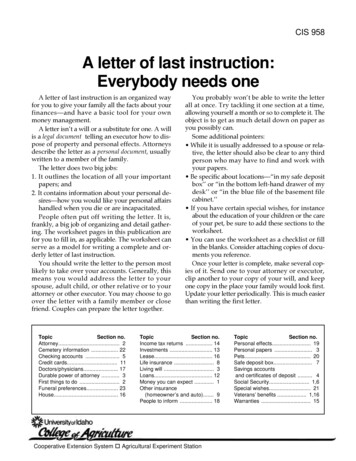
![Last or Business First [Maiden] Page Title Notes](/img/1/saukcity125thjubilee-20historical-20album-index.jpg)
